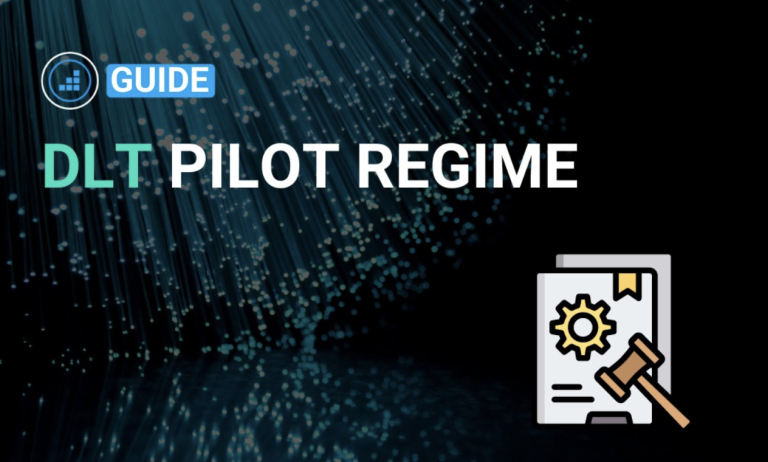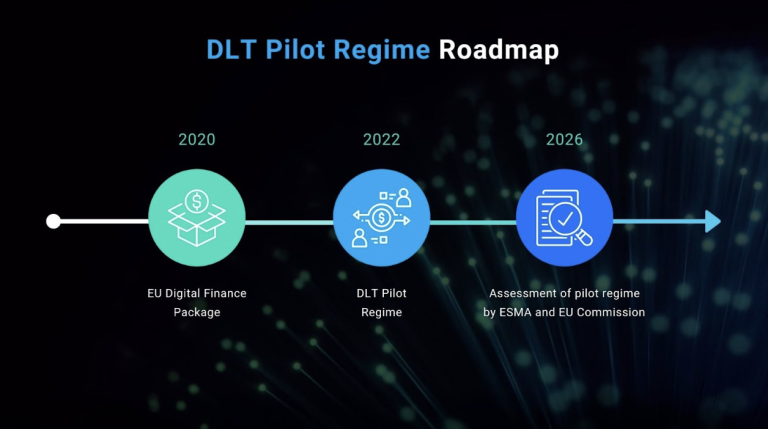An overview of the technical insights of the DLT Pilot Regime
Today, the European Union (EU) law framework regulating capital markets is not tailored to accommodate emerging technologies like DLT Market Infrastructure (DLT MI). To address this, the EU introduced the Pilot Regime for Market Infrastructures based on DLT Regulation 2022/858/EU (Pilot Regime). This insight provides an overview of the Pilot Regime’s innovative aspects which came into force on 23rd March 2023 and is directly applicable to Malta.
On a European level, this Pilot Regime introduces a regulatory sandbox allowing market operators to experiment with DLT within the financial market industry while remaining compliant with EU law. Such a move is expected to enhance legal certainty and consumer protection, but it also represents a significant shift in financial market legislation, introducing the concept of decentralisation of financial instruments.

The Aims of the Pilot Regime
Will the DLT Pilot Regime revolutionise capital markets in Europe?
Accordingly, the main goals of the Pilot Regime are to:
- remove regulatory barriers to the issuing, trading, and settlement of DLT Financial Instruments (DLT FIs) in exchange for certain guarantees;
- establish safeguards for secure DLT adoption in financial markets; and
- allow the European Securities and Markets Authority (ESMA) and relevant authorities to gain practical experience with DLT MIs and DLT FIs.
The Pilot Regime stipulates that applicants can obtain authorisation as either an investment firm or a market operator under the Markets in Financial Instruments Directive (MiFID), or as a Central Securities Depository (CSD) under the Central Securities Depositary Regulation 909/2014 (CSDR), depending on the type of DLT MI they intend to operate. Nonetheless, the Pilot Regime is also accessible to new entrants without prior authorisation, given that they concurrently apply for authorisation under MiFID and/or CSDR (as relevant) while seeking inclusion in the Pilot Regime.
Additionally, it’s worth noting that entities aiming to participate in alternative roles (e.g., as an investor or issuer of a DLT financial instrument) will need to collaborate with a DLT MI operator. This partnership is requisite for firms seeking involvement beyond the scope of operating a DLT MI.
What are the three primary categories that the Regulation encompasses?
Will the DLT Pilot Regime revolutionise capital markets in Europe?
- DLT Multilateral Trading Facilities (MTFs): These are MTFs that exclusively facilitate the trading of DLT FIs. A DLT MTF should be a MTF that is operated by an investment firm or a market operator authorised under MiFID.
- DLT Settlement Systems (SS): These systems aid the settlement of DLT FIs by managing payment or delivery processes, as well as handling initial record-keeping and safekeeping services for these DLT FIs. A DLT SS should be operated by a CSD licensed under the CSDR.
- DLT Trading and Settlement Systems (TSS): This category encompasses DLT MTFs or DLT SSs that integrate the functionalities of both a DLT MTF and DLT SS. This novel regulatory status allows operators to provide services across the entire product lifecycle, a departure from conventional norms where trading and settlement functions are carried out by distinct market infrastructures. A DLT TSS should be operated by an investment firm or market operator or a CSD that has received specific permission to operate a DLT TSS under this Pilot Regime.
Admission to trading or recording on a DLT MI under the Pilot Regime is limited to the following DLT FIs:
- Shares, the market capitalisation of which must be below €500 million;
- Bonds and other forms of securitised debt, including depositary receipts, or money market instruments with a value of less than €1 billion;
- Units in collective investment undertakings – the market value of the assets under management must be below €500 million;
The total value of all DLT financial instruments must not exceed €6 billion.
The central element of the Pilot Regime revolves around the provision of 20 distinct waivers from specific regulatory obligations laid out in MiFID II, MiFIR, and CSDR. These waivers create a distinctive testing environment for DLT MIs, where firms can experiment under the oversight of the relevant National Competent Authority (NCA).
Each exemption must be individually requested as part of the application process. Those planning to operate a DLT MTF can seek the MiFID II and MiFIR exemptions specified in Articles 4(2) and (3) of the Pilot Regime. Those intending to operate a DLT SS can apply for the CSDR exemptions outlined in Article 5(2) to (9) of the Pilot Regime. Meanwhile, applicants aiming to establish a DLT TSS can apply for both sets of exemptions.
What are the most crucial factors applicants should bear in mind when seeking exemptions under the Pilot Regime?
Will the DLT Pilot Regime revolutionise capital markets in Europe?
- Exemptions are specifically targeted, addressing regulatory requirements that impede DLT-based testing in an MI context.
- Compliance with all other regulatory obligations, including those under MiFID II, MiFIR, and CSDR, remains essential.
- Granted exemptions come with specific conditions and compensatory measures designed to mitigate associated risks from an investor protection, market integrity, and financial stability standpoint. Firms need to elucidate proposed compensatory measures and detail compliance with conditions specified in the Pilot Regime as part of their application.

What are the criteria for submitting an application under the DLT Pilot Regime?
Will the DLT Pilot Regime revolutionise capital markets in Europe?
To participate in the Pilot Regime, Applicants must submit to their respective NCA, distinct categories of information as part of their application, which are delineated in Articles 8(4), 9(4), and 10(4) of the Pilot Regime. These requirements are further outlined in separate tables within the annex of the DLT Guidelines.
In summary:
- Table 1 encompasses fundamental details necessary for all applicants, including the applicant’s name, LEI, the type of DLT MI being sought, and existing MiFID II or CSDR authorisations (if applicable).
- Table 2 encompasses more intricate information required from all applicants, such as the business plan outlining the applicant’s operational strategies, rules governing the proposed DLT MI, technical specifics about the DLT components, and particulars of the applicant’s transition strategy.
- Table 3 is relevant only to applicants seeking to operate a DLT MTF or DLT TSS, listing two potential exemptions that these operators may request.
- Table 4 pertains to applicants intending to operate a DLT SS or DLT TSS, outlining 18 potential exemptions for these operators.
Additional stipulations might be introduced by NCAs in the future, and ESMA is also expected to issue supplementary guidance that could impact forthcoming applications.
The Pilot Regime requires the operator of a DLT market infrastructure to transition/reverse its DLT infrastructure to traditional market infrastructure in the event that the:
- aggregate value of DLT FIs admitted to the DLT MI exceeds EUR 9 billion;
- specific permission is withdrawn or otherwise discontinued (including as a consequence of the Pilot Regime itself being discontinued); or
- applicant voluntarily ceases operation of its DLT MI.
How long is permission granted for and what comes next?
Will the DLT Pilot Regime revolutionise capital markets in Europe?
The permission to operate a DLT MI in accordance with the Pilot Regime is limited to a period of up to six years. This is why NCAs, prior to granting authorisation to operate a DLT MI, will ensure that applicants provide details of their transition strategy.
Up next: By 2026, the European Commission is obligated to present its perspective on the future role of the Pilot Regime. This evaluation will be presented in the form of a report to both the European Parliament and Council. The report will encompass a comprehensive assessment of costs and benefits, aimed at determining whether the Pilot Regime should:
- be extended for an additional period of up to three years;
- be expanded to encompass other categories of financial instruments that can be issued, registered, exchanged, or stored utilising distributed ledger technology;
- undergo modifications;
- be established as a permanent framework by appropriately amending pertinent EU financial services legislation; or
- be concluded, encompassing all permissions granted under the Pilot Regime.
More about MK Fintech Partners Ltd.
Michael Kyprianou Fintech Partners Ltd. is a Maltese company providing services in the FinTech sector. It comprises a team of dedicated experts who provide services such as Legal Advisory, Crypto Licensing, Token Issuers’ Licensing, Investment Services Licensing, and registrations of activities related to Fintech, Crypto, Blockchain & Data Protection, Investment Funds Services & Banking, Company Incorporations, and M&As.
MK Fintech Partners forms part of the Michael Kyprianou Group, a top tier international legal and advisory firm. It has established an enviable reputation as a broad-based legal practice over the years. Mainly by keeping at heart its principle to always exceed its clients’ expectations. MK has grown to become one of the largest law firms in Cyprus with offices in Nicosia, Limassol and Paphos. The MK Group’s international presence also includes fully-fledged offices in Greece (Athens and Thessaloniki), Malta (Birkirkara), Ukraine (Kiev), the United Arab Emirates (Dubai), United Kingdom (London), Israel (Tel Aviv), and Germany (Frankfurt).
The content of this article is valid at the date of its first publication. It intends to provide a general guide to the subject matter and does not constitute legal advice. We recommend that you seek professional advice on a specific matter before acting on any information you read. For further information, contact us at MK Fintech Partners via email at contactmkfintech@kyprianou.com or by telephone +356 2016 1010.




